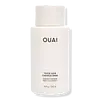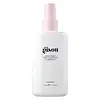What's inside
What's inside
 Key Ingredients
Key Ingredients

 Benefits
Benefits

 Concerns
Concerns

 Ingredients Side-by-side
Ingredients Side-by-side

Water
Skin ConditioningCetearyl Alcohol
EmollientBehentrimonium Chloride
PreservativeParfum
MaskingCetrimonium Chloride
AntimicrobialPanthenol
Skin ConditioningHydrolyzed Keratin
HumectantPersea Gratissima Oil
Skin ConditioningAlthaea Officinalis Root Extract
Skin ConditioningDimethicone
EmollientAmodimethicone
Butyrospermum Parkii Butter
Skin ConditioningPolyquaternium-37
Dicaprylyl Carbonate
EmollientLauryl Glucoside
CleansingDivinyldimethicone/Dimethicone Copolymer
C11-15 Pareth-7
EmulsifyingLaureth-9
EmulsifyingGlycerin
HumectantTrideceth-12
EmulsifyingC12-13 Pareth-23
CleansingC12-13 Pareth-3
EmulsifyingDimethiconol
EmollientPropoxytetramethyl Piperidinyl Dimethicone
Trideceth-6
EmulsifyingEthylhexylglycerin
Skin ConditioningTocopherol
AntioxidantIsopropyl Alcohol
SolventGuar Hydroxypropyltrimonium Chloride
Skin ConditioningCitric Acid
BufferingSodium Chloride
MaskingSorbitan Oleate
EmulsifyingSodium Hydroxide
BufferingAcetic Acid
BufferingSodium Acetate
BufferingPhenoxyethanol
PreservativePotassium Sorbate
PreservativeBenzyl Salicylate
PerfumingLimonene
PerfumingHexyl Cinnamal
PerfumingWater, Cetearyl Alcohol, Behentrimonium Chloride, Parfum, Cetrimonium Chloride, Panthenol, Hydrolyzed Keratin, Persea Gratissima Oil, Althaea Officinalis Root Extract, Dimethicone, Amodimethicone, Butyrospermum Parkii Butter, Polyquaternium-37, Dicaprylyl Carbonate, Lauryl Glucoside, Divinyldimethicone/Dimethicone Copolymer, C11-15 Pareth-7, Laureth-9, Glycerin, Trideceth-12, C12-13 Pareth-23, C12-13 Pareth-3, Dimethiconol, Propoxytetramethyl Piperidinyl Dimethicone, Trideceth-6, Ethylhexylglycerin, Tocopherol, Isopropyl Alcohol, Guar Hydroxypropyltrimonium Chloride, Citric Acid, Sodium Chloride, Sorbitan Oleate, Sodium Hydroxide, Acetic Acid, Sodium Acetate, Phenoxyethanol, Potassium Sorbate, Benzyl Salicylate, Limonene, Hexyl Cinnamal
Water
Skin ConditioningBehenamidopropyl Dimethylamine
EmulsifyingCetearyl Alcohol
EmollientLactic Acid
BufferingAdansonia Digitata Seed Oil
EmollientArgania Spinosa Kernel Oil
EmollientMel
EmollientSodium Benzoate
MaskingHydroxypropyltrimonium Honey
Panthenol
Skin ConditioningParfum
MaskingHydrolyzed Wheat Protein
Skin ConditioningHydrolyzed Adansonia Digitata Seed Extract
Benzyl Alcohol
PerfumingSaccharomyces/Magnesium Ferment
Sorbic Acid
PreservativeSaccharomyces/Iron Ferment
Skin ConditioningPotassium Sorbate
PreservativeSaccharomyces/Zinc Ferment
Skin ConditioningSaccharomyces/Copper Ferment
Skin ConditioningSaccharomyces/Silicon Ferment
Skin ConditioningCoumarin
PerfumingHexyl Cinnamal
PerfumingLimonene
PerfumingLinalool
PerfumingWater, Behenamidopropyl Dimethylamine, Cetearyl Alcohol, Lactic Acid, Adansonia Digitata Seed Oil, Argania Spinosa Kernel Oil, Mel, Sodium Benzoate, Hydroxypropyltrimonium Honey, Panthenol, Parfum, Hydrolyzed Wheat Protein, Hydrolyzed Adansonia Digitata Seed Extract, Benzyl Alcohol, Saccharomyces/Magnesium Ferment, Sorbic Acid, Saccharomyces/Iron Ferment, Potassium Sorbate, Saccharomyces/Zinc Ferment, Saccharomyces/Copper Ferment, Saccharomyces/Silicon Ferment, Coumarin, Hexyl Cinnamal, Limonene, Linalool
Ingredients Explained
These ingredients are found in both products.
Ingredients higher up in an ingredient list are typically present in a larger amount.
Cetearyl alcohol is a mixture of two fatty alcohols: cetyl alcohol and stearyl alcohol. It is mainly used as an emulsifier. Emulsifiers help prevent the separation of oils and products. Due to its composition, it can also be used to thicken a product or help create foam.
Cetearyl alcohol is an emollient. Emollients help soothe and hydrate the skin by trapping moisture.
Studies show Cetearyl alcohol is non-toxic and non-irritating. The FDA allows products labeled "alcohol-free" to have fatty alcohols.
This ingredient is usually derived from plant oils such as palm, vegetable, or coconut oils. There is debate on whether this ingredient will cause acne.
Due to the fatty acid base, this ingredient may not be Malassezia folliculitis safe.
Learn more about Cetearyl AlcoholHexyl Cinnamal is a fragrance ingredient with a similar scent to jasmine. It can be naturally found in chamomile essential oil.
This ingredient is a known EU allergen and may sensitize the skin. The EU requires this ingredient to be listed separately on an ingredients list.
Hexyl Cinnamal is not water soluble but is soluble in oils.
Learn more about Hexyl CinnamalLimonene is a fragrance that adds scent and taste to a formulation.
It's found in the peel oil of citrus fruits and other plants such as lavender and eucalyptus. The scent of limonene is generally described as "sweet citrus".
Limonene acts as an antioxidant, meaning it helps neutralize free radicals.
When exposed to air, oxidized limonene may sensitize the skin. Because of this, limonene is often avoided by people with sensitive skin.
The term 'fragrance' is not regulated in many countries. In many cases, it is up to the brand to define this term. For instance, many brands choose to label themselves as "fragrance-free" because they are not using synthetic fragrances. However, their products may still contain ingredients such as essential oils that are considered a fragrance.
Learn more about LimonenePanthenol is a common ingredient that helps hydrate and soothe the skin. It is found naturally in our skin and hair.
There are two forms of panthenol: D and L.
D-panthenol is also known as dexpanthenol. Most cosmetics use dexpanthenol or a mixture of D and L-panthenol.
Panthenol is famous due to its ability to go deeper into the skin's layers. Using this ingredient has numerous pros (and no cons):
Like hyaluronic acid, panthenol is a humectant. Humectants are able to bind and hold large amounts of water to keep skin hydrated.
This ingredient works well for wound healing. It works by increasing tissue in the wound and helps close open wounds.
Once oxidized, panthenol converts to pantothenic acid. Panthothenic acid is found in all living cells.
This ingredient is also referred to as pro-vitamin B5.
Learn more about PanthenolParfum is a catch-all term for an ingredient or more that is used to give a scent to products.
Also called "fragrance", this ingredient can be a blend of hundreds of chemicals or plant oils. This means every product with "fragrance" or "parfum" in the ingredients list is a different mixture.
For instance, Habanolide is a proprietary trade name for a specific aroma chemical. When used as a fragrance ingredient in cosmetics, most aroma chemicals fall under the broad labeling category of “FRAGRANCE” or “PARFUM” according to EU and US regulations.
The term 'parfum' or 'fragrance' is not regulated in many countries. In many cases, it is up to the brand to define this term.
For instance, many brands choose to label themselves as "fragrance-free" because they are not using synthetic fragrances. However, their products may still contain ingredients such as essential oils that are considered a fragrance by INCI standards.
One example is Calendula flower extract. Calendula is an essential oil that still imparts a scent or 'fragrance'.
Depending on the blend, the ingredients in the mixture can cause allergies and sensitivities on the skin. Some ingredients that are known EU allergens include linalool and citronellol.
Parfum can also be used to mask or cover an unpleasant scent.
The bottom line is: not all fragrances/parfum/ingredients are created equally. If you are worried about fragrances, we recommend taking a closer look at an ingredient. And of course, we always recommend speaking with a professional.
Learn more about ParfumPotassium Sorbate is a preservative used to prevent yeast and mold in products. It is commonly found in both cosmetic and food products.
This ingredient comes from potassium salt derived from sorbic acid. Sorbic acid is a natural antibiotic and effective against fungus.
Both potassium sorbate and sorbic acid can be found in baked goods, cheeses, dried meats, dried fruit, ice cream, pickles, wine, yogurt, and more.
You'll often find this ingredient used with other preservatives.
Learn more about Potassium SorbateWater. It's the most common cosmetic ingredient of all. You'll usually see it at the top of ingredient lists, meaning that it makes up the largest part of the product.
So why is it so popular? Water most often acts as a solvent - this means that it helps dissolve other ingredients into the formulation.
You'll also recognize water as that liquid we all need to stay alive. If you see this, drink a glass of water. Stay hydrated!
Learn more about Water